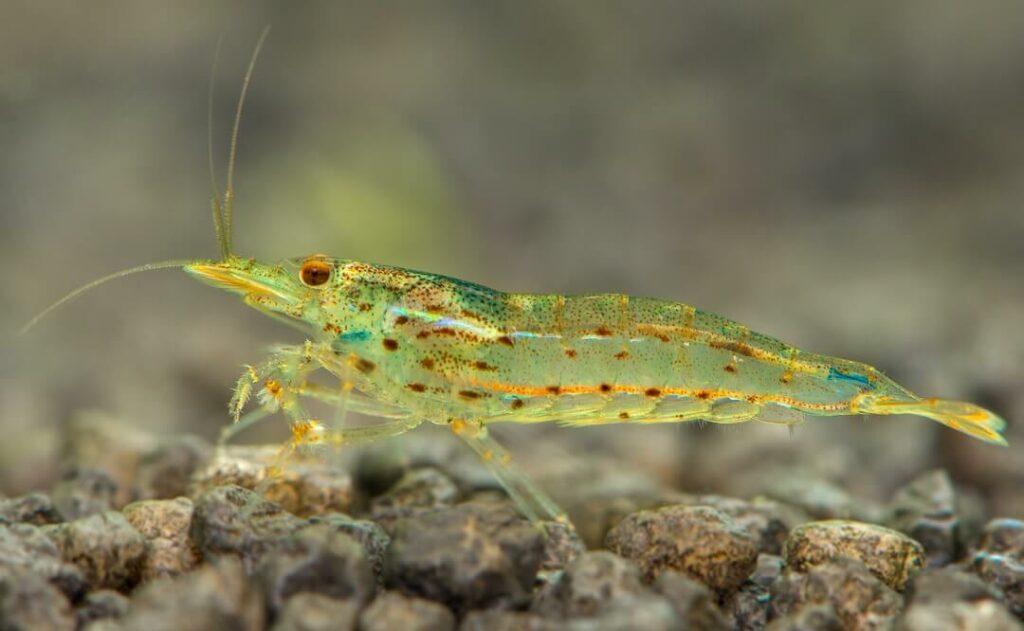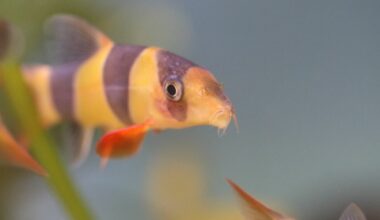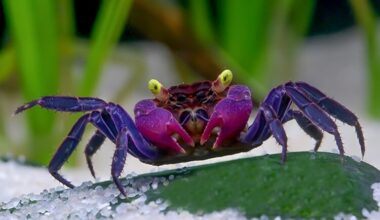
Amano shrimp are one of the most popular freshwater shrimps around. It’s hard to find someone with a freshwater tank who hasn’t at least considered adding them to their aquarium at one point.
They’re hardy, peaceful, and jump at the opportunity to scarf down any algae that’s in your tank.
Amano shrimp are also a lot of fun to watch. They are very active creatures who always seem to be up to something!
When you add all of these benefits together (not to mention the extremely low required care level) it’s no wonder they’re a fan favorite.
In this care guide, we take a deep look at Amano shrimp so you can find out if they’re right for you, provide better care, or just learn for fun!
Quick Facts 
| Scientific Name: | Caridina Multidentata |
| Other Names: | Yamato Shrimp, Japanese Algae-Eater Shrimp, Algae-Eating Shrimp, Amano Atya, Caridina Amano |
| Lifespan: | 2-3 years |
| Size: | 2 inches |
| Care: | Easy |
| Diet: | Omnivorous |
| Water Conditions: | 72°F-78°F, 7.2-7.5 pH |
| Tank Size: | 10 Gallons |
| Behavior: | Quite Peaceful |
| Breeding Difficulty: | High |
Table of Contents
What are Amano shrimp?
The Amano shrimp is a fascinating species of freshwater shrimp that is very common in the aquarium trade. It is native to Taiwan and Japan and can grow up to 2 inches in length. It goes by many names, including Japanese shrimp, Japanese swamp shrimp, Japanese algae eaters, Japonica shrimp, algae shrimp, and Yamato shrimp.
This shrimp’s scientific names are Caridina multidentata and Caridina japonica. By far the Amano is one of the most popular species of shrimp for aquarium hobbyists, second only to the Cherry shrimp.
It was originally introduced to the aquarium world by popular aquarist, track cyclist, and photographer Takashi Amano when he discovered they can eat large quantities of algae, and keep an aquarium clean (not cloudy) when they were introduced and maintained in large numbers.
Appearance
Amano shrimp is known as one of the largest “dwarf shrimp” species on the aquarium hobbyist market. They are easily recognizable with a large body that is either gray or transparent, with dark-colored dots running along their length.
These shrimp are very effective at being able to camouflage themselves into the natural environment, or their surroundings in your aquarium. It gives them an edge in the wild, where many animals consider them food.
When shopping for your shrimp, bear in mind that there are roughly 200 other species of Caridina, and some of them can easily be mistaken for Amano shrimp.
To make sure you have Amano, look at its behavior in how it cleans the tank. A genuine Amano will relentlessly search out algae and other food in every crack and crevice, while similar shrimp will be lazy by comparison.
Temperament
You will be glad to hear these shrimp are normally quite peaceful. If you introduce food to the tank, they will race to it and swarm over it. Otherwise, they are content to mind their own business as they pick at the dead matter from aquarium plants.
They can also be seen eating algae as soon as it starts to accumulate in the tank. Their talent at eating algae is one reason why they are so popular among aquarium owners. They love having lots of plants to explore and climb on.
Like other shrimp, they will molt their exoskeletons (generally this happens at the rate of once per month), and for a short time they will be soft as the new armor hardens up. During this time they will feel vulnerable and may prefer to stay hidden.
After molting, they are likely to eat the old exoskeleton. They do this because their original armor contains minerals that help their new shell harden faster, so they can be better protected in the wild.
Author Note: They will feel more secure and at peace if you give them plenty of plants and other places where they can hide. And of course, the less stress they have the more likely they are to survive and stay healthy.
What is the average Amano shrimp lifespan?
The normal lifespan for a healthy Amano shrimp in captivity is usually between two and three years. Amano shrimp can easily die at a young age, soon after they are added to the aquarium.
You will want to keep an eye on them to make sure they are still alive and are not eaten by any of their tank mates for the first few weeks.
Tank requirements & water conditions
To ensure they are as healthy as possible, keep the water parameters as close as possible to the below.
- Temperature: 72 and 78 degrees Fahrenheit
- pH levels: 2 and 7.5
- Lighting: Standard aquarium lighting
- Water changes: 10% to 25% every 1 to 2 weeks

Make sure to introduce your shrimp to an established tank that has some algae growth already on its surface. This will feed them right away and help them better acclimate. Your shrimp are less likely to survive if you put them in a pristine tank without any algae.
Live plants like Green Cabomba and Java Moss will help them feel more comfortable. Hiding places like rocks, shrimp tubes, and submerged branches are good options.
Author Note: See if you can coat the bottom of the tank with tiny rocks or pebbles, to mimic their natural habitats in Japan and Taiwan.
Feed them regularly and give them a low-stress environment with plenty of hiding places, so they feel as safe and secure as possible. If they live past those crucial first weeks, you can expect them to live for a very long time (for a shrimp).
You’ll also want to make sure that there isn’t any copper in the tank. This element can wreak havoc on any invertebrates in your tank, and Amano shrimp are no exception (no matter how hardy they might be).
Amano shrimp diet
In nature, Amano shrimp are omnivorous. They will scavenge dead and decaying matter from plants and animals, as well as debris building up in their underwater environment. This makes them excellent additions to your tank, like a natural cleaning crew. If a fish dies in your tank, the shrimp will even help clean up its carcass.
If you are going to keep them in captivity, remember this important bit of advice: Amano shrimp do not only eat algae and dead plants. Your shrimp already love feeding on those, but do not forget to supplement that with other things. Also, keep in mind that they do not eat black beard algae, so be prepared to take that into account.
There are plenty of algae pellets and wafers you can buy at any aquarium store. A diverse diet with frozen protein like bloodworms and brine shrimp will come in handy for helping your Amano shrimp continue to thrive, and it is easy to find quality food for them.
Author Note: They also like to dine on vegetables, like squash and spinach, cucumbers, and zucchini. But blanch the vegetables first and pay attention to the amount of food you give them. Remove the veggies from your tank after one hour to avoid contaminating the water.
Make sure to read the list of ingredients in the food and medicines since as we shared, copper will harm your shrimp and any other invertebrates.
Good and bad Amano shrimp tank mates
These shrimp can do just fine on their own, but you may decide it is better to have them sharing a tank with other creatures. This can be a little tricky since many creatures like to eat Amano shrimp. After all, they lack almost any means to defend themselves from attackers.
Keep in mind, your biggest Amano will usually get the first share of food that is dropped. They have a natural pecking order, and the largest one in the tank will intimidate the others until it is their turn to feed.
They get along well with others of their own kind, but bigger shellfish are liable to consider them a light snack. Keep them away from aquarium crayfish or freshwater lobsters. On the other hand, other shrimp like Cherry shrimp and Bamboo shrimp will not pose a threat to them.
Aggressive or large fish do not make good roommates for them. Goldfish and cichlids are not an option, nor are bettas, arowanas, or Oscars. However, they do get along with Octocinclus catfish, Cory catfish, and neon tetras, as well as other non-aggressive fish.
Numerous freshwater snails make great companions (and fellow tank cleaners) as well. Golden Inca snails, Malaysian trumpet snails, Assassin snails, Ramshorn snails, Mystery snails, Ivory snails, and Japanese trapdoor snails are just a few of the species that get along well with Amano shrimp.
Author Note: Try to keep your shrimp in groups of half a dozen or more. This will limit their dominance behavior, and help them continue to get along with any other species you introduce.
Since Amano shrimp are so peaceful by nature, they will not pose any threat to the other creatures in their tank. They will busily look in every hiding place for algae and other matter to feed on, minding their own business and not getting in the way of the other animals or pushing them around.
Amano shrimp care is easy, and keeping them can serve a practical purpose in keeping your tank clean of unsightly algae buildup (just like Siamese algae eaters), and they are guaranteed to add variety and entertainment to a freshwater aquarium.
How many shrimp per gallon?
The minimum tank size for your Amano shrimp should be ten gallons. After that, you’ll want to add two gallons for every additional shrimp in the tank.
However, this is not a firm rule since their biomass is so low. This means they make a very low impact on the tank’s ecosystem. It’s almost impossible for you to overstock the aquarium.
Ways to tell the difference between male and female Amano shrimp
Whereas it can be difficult to tell males apart from females in other species of aquarium shrimp (like the Cherry shrimp), the two sexes of the Amano shrimp are easily distinguishable.
Differences
- The males are much smaller than the females, and the dots along the sides of their exoskeleton tend to be small and evenly spaced.
- Females are bigger, and many of their markings are stretched out into a series of dashes along the sides of their body.

Keep in mind that a female will also have something called a saddle under her stomach. Think of this as a purse or compartment where she can safely store thousands of her eggs.
Amano shrimp breeding advice
The majority of Amano shrimp on the market are in fact caught in the wild, rather than coming from breeder tanks. This is because it is extremely difficult for all but the most experienced aquarium hobbyists to try and breed them. If you are breeding shrimp for the first time, I highly recommend either the Ghost shrimp or Cherry shrimp, as the care of both species’ adults and larvae will be much easier.
Breeding Process in the Wild
- Female Amano shrimp will lay between 1,000 and 3,000 green colored eggs, which will be attached to the underside of her body for up to five weeks.
- When they hatch and are released from their mother, the larvae need brackish water to grow to full maturity, and then they migrate back from the ocean to freshwater as soon as they reach adulthood.
Unfortunately, the adults can easily die if exposed to water that contains any salt. If you decide to try breeding Amano shrimp in spite of the difficulty, make sure you remove the adults quickly from any breeding tanks, then carefully increase the water’s salinity.
Breeders have managed to breed them when the water’s salinity is at full strength, at 1.024.
Are you sold yet?
Now that you know the essential information about Amano shrimp and how to take care of them, it’s time to decide if they’re right for you.
If you already have some and just wanted to learn more, we hope you found what you were looking for!
If you’re still on the fence, let us help sway you.
Adding Amano shrimp to your tank is a pretty risk-free thing to do. As long as your aquarium conditions and their tank mates are compatible, your new shrimp will be quite happy!
They’re an animal that just wants to mind their business and munch on some algae.
What’s not to like? If you have any other questions about Amano shrimp you can always get in touch with us and ask us directly. By the way, sharing is caring so feel free to tag us on Facebook when sharing cool photos of your shrimp.

